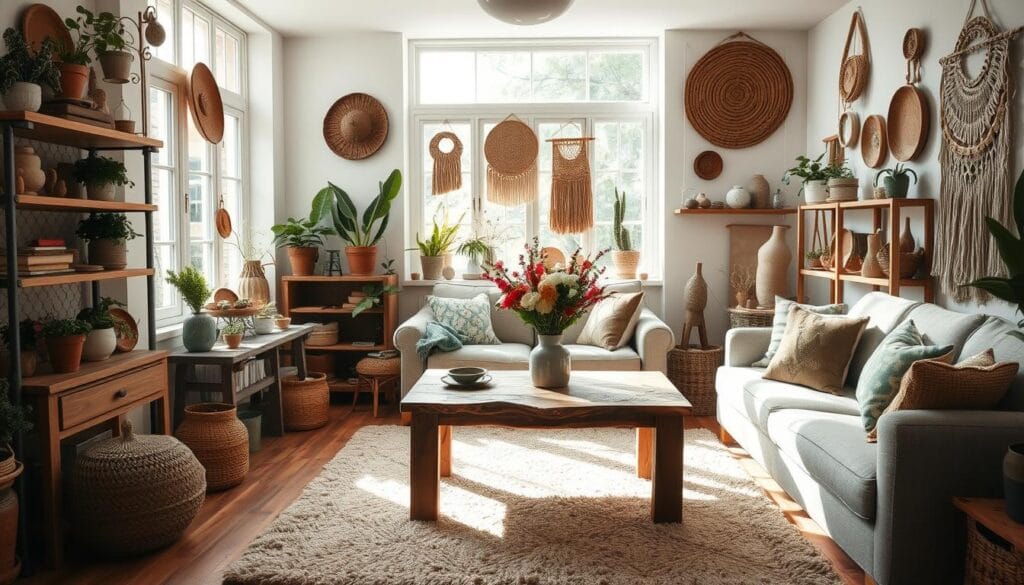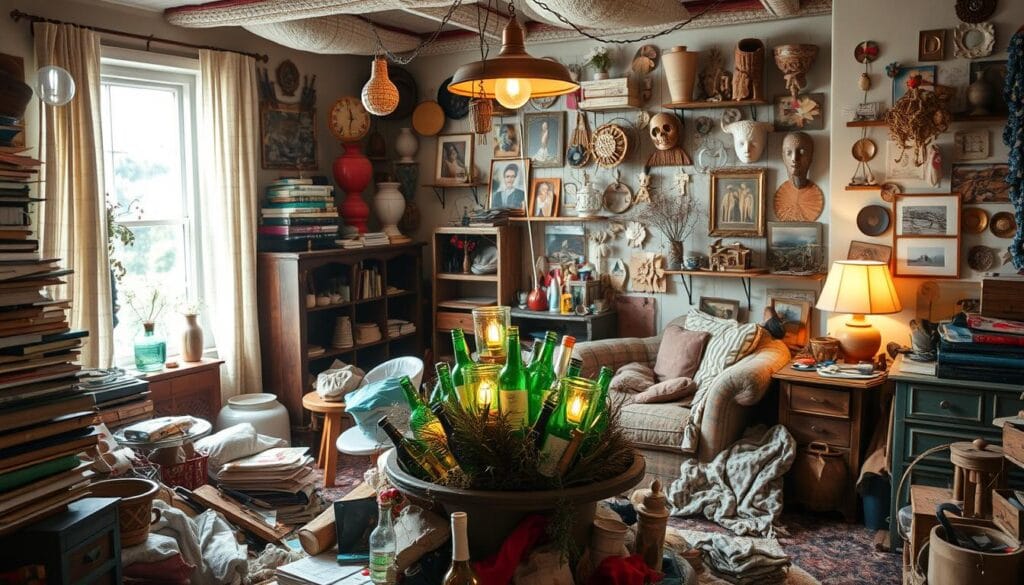Have you ever looked at a pile of items you thought were useless and wondered if they could be useful again? I once saw an old wooden pallet behind a local hardware store. Most people might see it as just scrap wood, ready for the trash. But for someone who loves DIY, it was a blank canvas. With creativity and some tools, that pallet became a stylish coffee table. It became the perfect centerpiece for my living room, showing what sustainable home decor is all about.
We waste so much every day. Did you know only 1% of what we buy is still used after six months? It’s shocking that 99% of what we buy is thrown away within six months. This shopping pattern not only costs us money but also harms our planet. By choosing eco-friendly home decor, we fight against this waste.
Let’s dive into the world of sustainable home decor. We’ll see how we can turn everyday items into stylish, useful home accents. Forget about products made to break down quickly. Let’s use creativity and skill to make our homes beautiful.
Repurposing saves money and promotes a meaningful way of living. It means breaking free from constant buying. You can turn old sheets into new cushion covers or make wall art from used clothing. The options for eco-friendly design are limitless and very motivating.
Key Takeaways
- Only 1% of purchased items are still in use after six months; let’s change that trend with sustainable home decor.
- Embrace eco-friendly home decor by repurposing everyday items into stylish home accents.
- Creative DIY projects can save homeowners approximately 50% compared to buying new decor items.
- Incorporating green interior design not only beautifies your space but also respects the environment.
- Repurposing can reduce household waste by up to 30%, significantly lowering your carbon footprint.
Introduction to Sustainable Home Decor
Welcome to sustainable home decor! 🌿 Making eco-friendly choices for our homes is more important than ever. The demand for green home decor is quickly growing. It’s expected to rise significantly until 2028 as we all look for eco-smart options.
Imagine your home with stylish recycled pieces. Exciting, isn’t it? Let’s explore how to make your space greener.
The Importance of Sustainability in Design
Design sustainability means picking materials that are kind to the planet, save resources, and promote health. The use of organic textiles has grown by 25% recently. This is due to more people caring about the environment. Upcycling can also reduce waste by 80% compared to regular manufacturing.
Going for green decorating choices helps the planet and looks good. Using energy-saving lights or bamboo furniture is part of this. It makes your home look better and helps the environment too.
Overview of Repurposing Everyday Items
Repurposing things is a great mix of creativity and eco-friendliness. It reduces the need to buy new items. This cuts waste and saves resources. Turning an old ladder into a shelf or using vintage cups as candle holders are just a few ideas.
About 30% of all furniture sold in the U.S. is sustainable now. This shows people prefer recycled and unique furniture pieces. It gives your home character and supports recycling efforts. Plus, you can save a lot of money by choosing repurposed items over new ones.
In the sections to follow, we’ll look at practical tips and guides for starting your eco-friendly decor project. Get ready to find out fun and beautiful ways to use everyday items in your decor! 💡
Benefits of Repurposing in Home Decor
Repurposing items for home decor is a great sustainable living idea. It turns discarded items into unique home accessories. This is good for the environment and saves money.
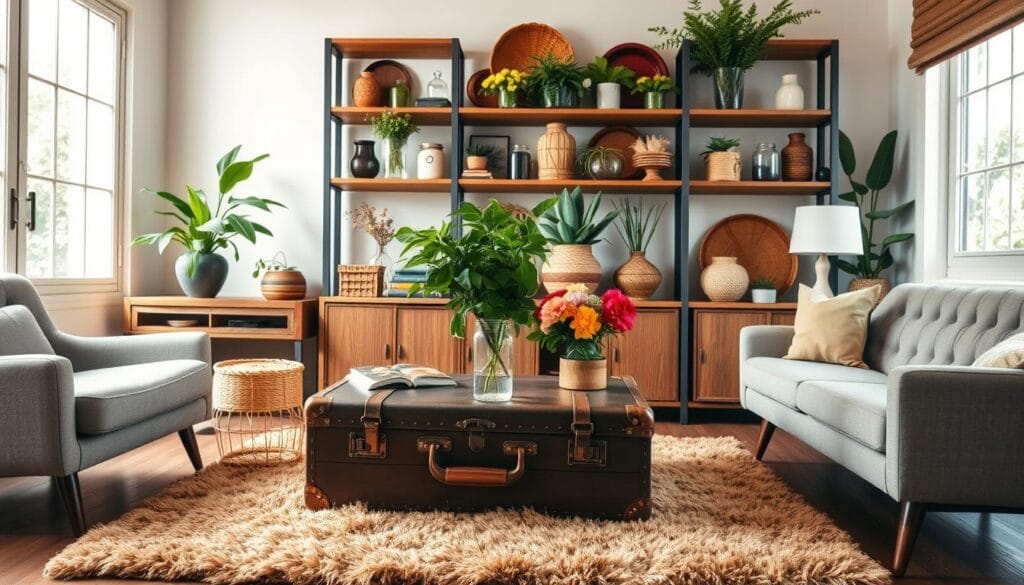
Environmental Impact of Repurposing
Repurposing materials means we use them longer and reduce waste. Making less new stuff saves energy and cuts greenhouse gases. This also uses fewer resources like timber and metals, protecting natural habitats.
Turning old things like t-shirts into cushion covers, or glass bottles into vases, reduces waste. Each upcycled item keeps waste out of landfills. Learn more about this in an article on upcycling in interior design.
Cost-Effectiveness of Upcycled Decor
Upcycled decor saves money over buying new. For example, old jeans can become stylish shorts or tote bags. Outdated electronics can turn into fish tanks or wall art.
This practice boosts creativity and eco-friendly living. You might turn kitchen appliances into planter pots or wooden pallets into coffee tables. It offers cost-effective decorating.
| Upcycling Project | Materials Used | Benefits |
|---|---|---|
| Stylish Shorts | Old jeans | Cost-effective decorating, reduced waste |
| Vases | Glass bottles | Reduced landfill waste, creative design |
| Cushion Covers | Old t-shirts | Personalized decor, conservation of resources |
| Planter Pots | Kitchen appliances | Innovative repurposing, lowered carbon footprint |
Upcycling encourages being creative and resourceful. It’s also a fun family activity that teaches eco-friendly habits. Let’s use these ideas to make our homes and planet better!
Creative Ideas for Repurposing Furniture
Repurposing furniture is a fun way to refresh your space and promote sustainability. About 77% of DIY fans are into repurposing for eco-friendly home decor. This trend is becoming very popular. Let’s dive into some imaginative ideas for redecorating and DIY projects that can bring a special charm to your home.
Transforming Old Chairs into Stylish Swings
Turning old chairs into chic outdoor swings is a top DIY project. First, take off the chair legs and hang the seat with ropes or chains. You’ll get a magical swing for your garden or porch. This idea not only makes your outdoor area look great but also supports reusing old furniture. And, it’s an enjoyable activity for the weekend!
Adding wheels to tables or changing dressers into new items are exciting ways to repurpose stylishly and sustainably. Discover more ideas here.
Making a Coffee Table from a Wooden Pallet
Using wooden pallets for new furniture is a hot trend. Recent surveys show 55% of DIYers have creatively used old furniture, especially wood pallets. To make a rustic coffee table, smooth the pallet, paint or varnish it, and add wheels. This adds a fashionable touch to your living room and shows the beauty of repurposed furnishings.
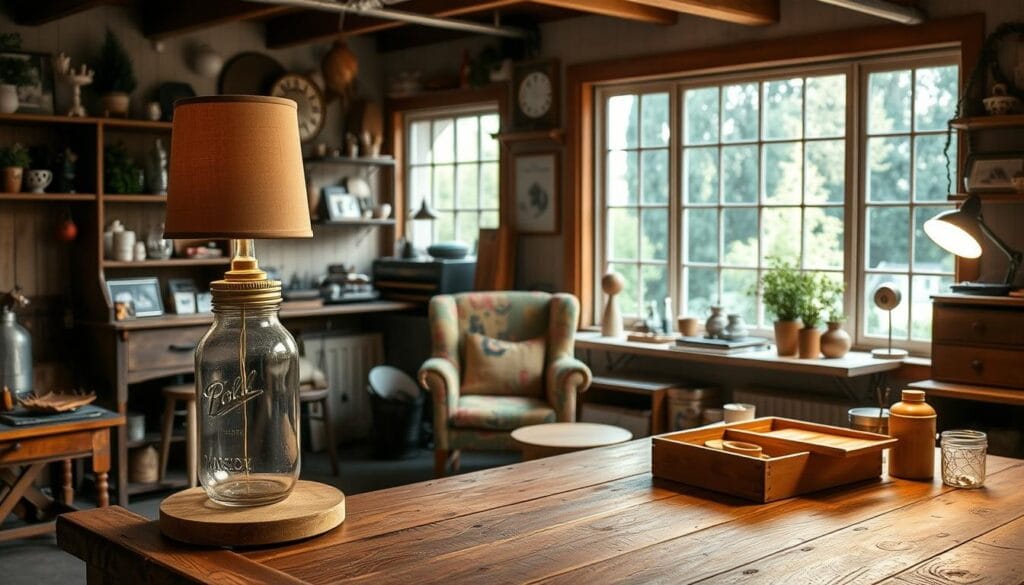
Reimagining Dressers into Unique Vanities
Turn an old dresser into a beautiful bathroom vanity to blend function and style. Remove the top drawers for a sink space, making a standout piece. Almost 70% of people think repurposed items make their homes more unique. This project isn’t just creative; it saves money and helps the planet by reducing waste.
Start your DIY repurposing projects by finding materials at thrift shops or using what you already have. With the growing trend of reusing old furniture, creating a stylish and green home is easier than ever. Try these imaginative decorating ideas to make your home uniquely sustainable.
Upcycling Fabrics for Sustainable Decor
Are you into eco-friendly home decor? Upcycling old textiles is a fun way to get creative! You can turn worn-out fabrics into cool, stylish items that make your space look new again. This is good for the environment and lets you show off your style.
Turning Vintage Sheets into Cushion Covers
Excited about making old sheets look new? Turning them into beautiful cushion covers is easy and rewarding. Simply cut the fabric, sew it together, and you’ve got yourself unique cushion covers. You’re not just being eco-friendly; you’re also making your space more personal. And you’re keeping fabrics out of the trash.
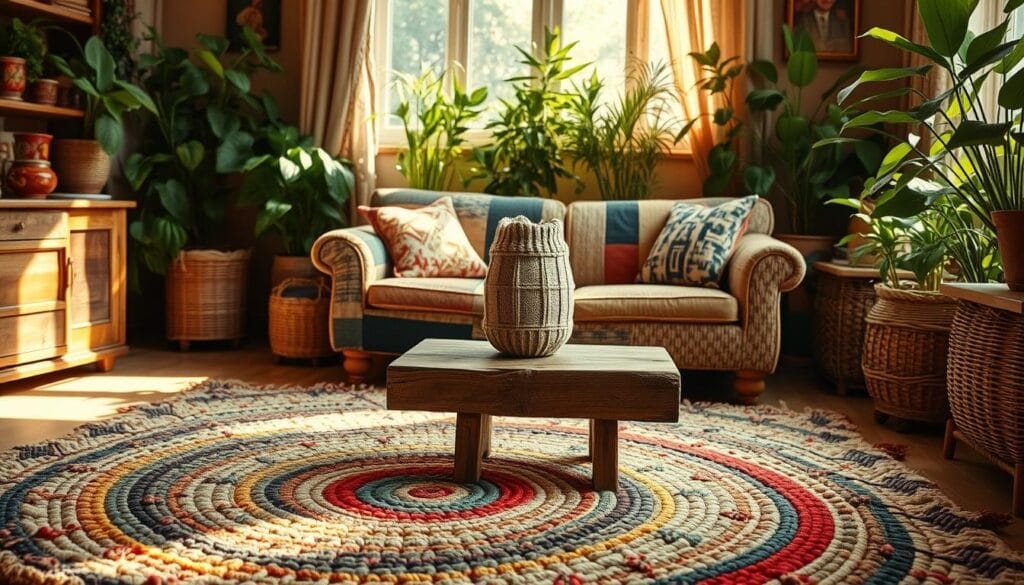
Creating Wall Art from Old Clothing
Don’t let old clothes clutter your closet. Use them to make amazing wall art instead. This project lets you explore creative ideas while sprucing up your home decor. Cut the fabric and arrange it on a canvas for eye-catching designs. You’ll end up with one-of-a-kind art that’s both beautiful and eco-friendly.
These DIY projects save money and help our planet by cutting down on waste. Around 85% of all textiles sadly end up in landfills every year. By upcycling, we play a part in changing this. It’s a chance to beautify our homes in a thoughtful, sustainable way. ❤️♻️
Using Glass and Plastic for Decorative Items
Using old glass jars and plastic bottles can make your home look creative while helping the environment. The DIY home decor market is growing. It’s expected to be worth $20 billion by 2027. This shows more people are doing sustainable DIY projects. Let’s explore how to use these common items in fun ways.
DIY Planters from Glass Jars
Turning glass jars into planters is a favorite idea. It’s a simple way to add plants to your space and cut down carbon emissions by 30%. With so many households having unused glass bottles, you have lots of options! You can paint the jars or tie them with twine for a special look.
Start by cleaning the jar well. Then, paint or decorate it any way you like. When it’s dry, fill it halfway with stones for water to drain, then add soil. Plant some herbs or small flowers. This reduces glass waste and makes your home greener.
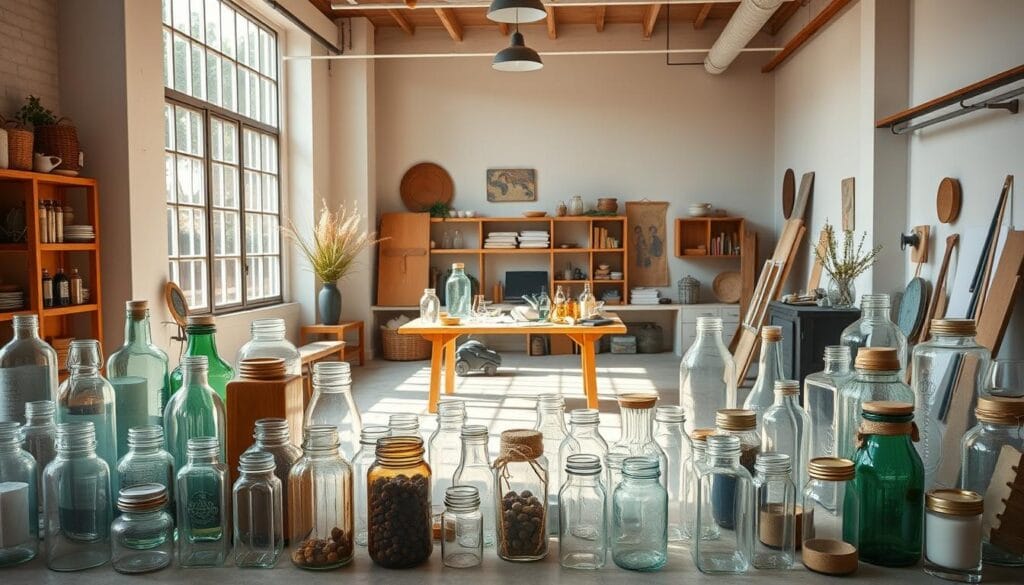
Upcycled Plastic Bottles as Outdoor Décor
Turning plastic bottles into useful things is becoming popular. It helps reduce plastic waste, which takes up to 450 years to break down. Making planters from plastic bottles can cut down waste by 1.5 million tons a year. Using old plastic bottles for outdoor decor saves money and is good for the planet.
To make one, cut a plastic bottle in half. Paint it with weatherproof paint. After it dries, make some holes in the bottom for water to drain out and add soil. Hanging these planters outdoors adds color and saves many plastic bottles from being thrown away.
Looking for more eco-friendly decorating ideas? Click here for DIY decor projects to try. Using these sustainable DIY projects makes your place look better and supports a healthier planet.
Incorporating Nature into Home Decor
Adding natural elements to your home makes it peaceful and welcoming. Biophilic design, like using nature in decor and eco-friendly ideas, improves the look and feel of your spaces. We’ll look into easy ideas to make nature a big part of your home and life.
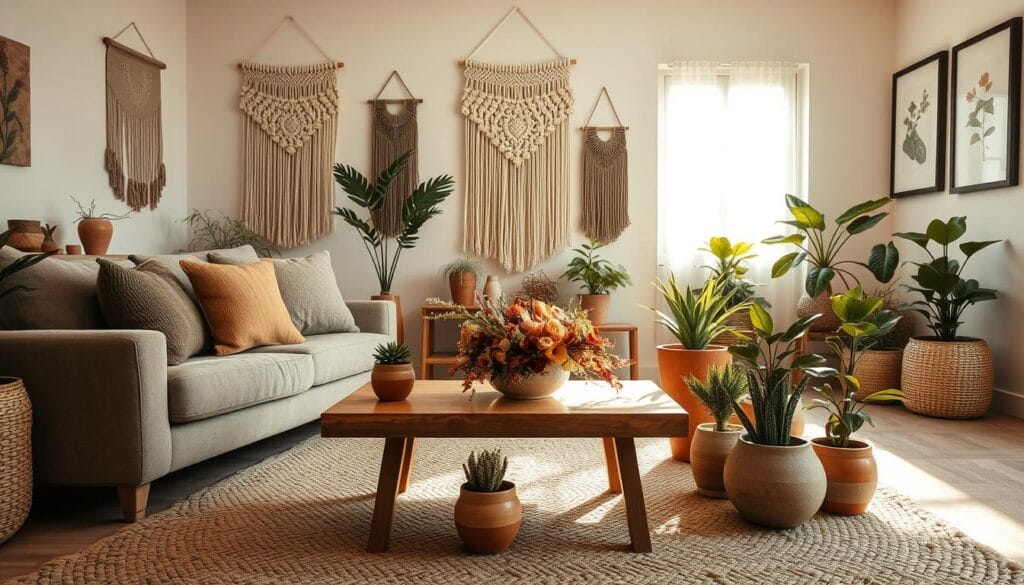
Using Fallen Branches as Wall Hangers
Turning fallen branches into unique wall hangers is a smart idea. First, clean them, dry them out, and smooth them with sandpaper. Attach them to your wall with solid hooks or brackets. This not only adds beauty but also creates space to hang things in an eco-friendly way.
Crafting Pinecone Centerpieces
Making pinecone centerpieces is a wonderful way to include nature in your home. Collect pinecones and place them in a clear vase or bowl. Brighten it up with some greenery or fairy lights for extra beauty. This easy and green project uses things found in nature to bring the outdoors inside.
Repurposing Kitchenware in Unique Ways
Turning kitchen items into decor adds charm and function to your home. Engaging in DIY kitchen decor boosts beauty and supports the environment. About 70% of discarded cookware can be reimagined or recycled. Plus, creative storage ideas help reduce waste, backing eco-friendly lifestyles.
Vintage Teacups as Candle Holders
Using vintage teacups as candle holders is a charming reuse idea. It combines utility with timeless elegance. Found at thrift stores, these teacups turn into cozy candle holders, brightening any room. Around 40% of people give old kitchenware to charities, making these items easy to find for DIY projects.
Using Mason Jars for Storage Solutions
Mason jars are stars in creative storage solutions. You can store things like spices, grains, or small tools in them. They also work well for holding office or craft supplies and bathroom items. The trend of upcycling has increased by 25% each year, showing a strong interest in sustainable decor. Upcycling mason jars clears clutter and brings a rustic vibe home, showing off your creativity and care for the environment.
Simple upcycling acts make a big difference. For example, repurposing kitchenware can cut waste by up to 50% compared to throwing things away. Let’s get behind repurposing, creating a green and beautiful space for us and the next generations.
| Item | Repurposed Use | Benefit |
|---|---|---|
| Vintage Teacups | Candle Holders | Creates cozy ambiance |
| Mason Jars | Storage Solutions | Organizes spaces |
| Old Pots | Planters | Reduces waste |
Getting Creative with Paper Products
Paper products are great for creating new things. You can turn old books into art or make bowls from newspapers. This is both fun and good for the planet.
Making Art from Repurposed Books
Turning books into art adds vintage charm to any room. You can fold, cut, and bind them into beautiful pieces. This shows off your creativity.
It’s easy to find old books at garage sales or thrift stores. Making art from them reduces waste and brings out your artistic skills. It’s a great way to craft with paper.
Crafting Decorative Paper Mache Bowls
Old newspapers can become beautiful paper mache bowls. You just need a balloon, flour, water, and newspapers. This is a great project for families to do together.
Layer newspaper with paste on a balloon to make these bowls. They’re strong and pretty when they dry. It’s a fun way to teach kids about recycling.
These paper crafts make your home look unique and help the environment. Using eco-friendly paper products shows you care about the planet. It lets you add a personal touch to your space.
Enhancing Decor with Repurposed Lighting
Adding a unique touch to your home is easy with repurposed lighting. Old lampshades and vintage lightbulbs are more than just outdated items. They’re perfect for creative and eco-friendly lighting solutions.
Transforming Old Lampshades into Works of Art
Don’t let those old lampshades gather dust in your attic. Turn them into innovative and green lighting ideas. Start by removing the old fabric from the lampshade frame. Then, use that frame as a base to add colorful threads or little decorations like beads and shells.
These revamped lampshades can become pendant lights or unique table lamps. Such DIY projects add personal flair to your decor.
Using Vintage Lightbulbs for Unique Lighting Solutions
Vintage lightbulbs can magically change your home’s feel. They’re not just for decoration; they spark great DIY lighting ideas. For example, combining vintage bulbs with a modern chandelier frame creates a mix of old and new charm.
You could also turn these bulbs into small terrariums or candles. These projects show how combining old items with new ideas can make your home look great and eco-friendly.
DIY lighting projects let your decor reflect your unique style while being kind to the environment. Repurposed lighting is not just about being green; it’s about making everyday items shine with new purpose.
Tips for Successful Repurposing Projects
Diving into DIY home projects can be very rewarding. It also helps our planet. Let’s look at some repurposing tips to make your projects both fruitful and creative.
Finding Inspiration from Home Decor Trends
Keeping up with home decor trends can inspire your projects. Fashion trends may spark new ideas. From simple to boho-chic, each trend offers a fresh perspective for your projects.
The use of reclaimed wood in decor has become popular. It brings a rustic feel and fights deforestation. Another idea is turning old fabrics into cushion covers or wall art. This gives old materials a new purpose and saves money.
“By repurposing everyday items, we not only reduce waste but also contribute to a more sustainable way of living. Every item has potential.” — Marie Kondo
Choosing the Right Tools and Materials
Having the right tools and materials is key for DIY projects. Good tools can help make the process better and more fun. You’ll need things like a versatile screwdriver set, a strong glue gun, and a good sewing kit.
Materials like reclaimed wood, vintage fabrics, and old jars can be found in thrift stores or at home. These materials can be used in many ways. For example, glass jars can be turned into over 15 different items, from storage solutions to decorative pieces.
| Item | Repurposing Ideas |
|---|---|
| Old Towels | Cleaning Rags, Bath Mats, Pet Beds |
| Plastic Bottles | Planters, Bird Feeders |
| Wine Corks | Coasters, Bulletin Boards |
| Old T-Shirts | No-Sew Blankets, Tote Bags, Headbands |
| Cereal Boxes | Storage Bins, Picture Frames, Bookmarks |
| Egg Cartons | Seed Starters, Craft Projects |
Approach each project with good planning and use these tips. You’ll finish your DIY projects successfully. You’ll create unique items and help our environment with your projects.
Sourcing Everyday Items for Repurposing
Looking for materials to repurpose doesn’t need to be expensive or hard. We can find plenty of items through thrift stores, swap events, and community recycling initiatives.
Thrift Stores: Treasure Troves for Decor
Thrift stores are amazing places to find items to repurpose. They have everything from old furniture to cool accessories. Every trip is a chance to find something special. Plus, buying from thrift stores helps the environment by reducing waste and promoting a culture of recycling.
A scratched table can be made new with some sanding and paint. Chairs that don’t match can be painted the same color and reupholstered. Doing this saves you money and reduces the need for new materials. It also saves energy needed to make new products.
The Role of Swap Events and Community Donations
Swap events and community recycling initiatives are great for finding items to repurpose. These events help build a close community by letting people trade things they don’t need anymore. It helps keep your home less cluttered and encourages everyone to live more sustainably. This can greatly reduce waste and the load on landfills.
Many towns hold swap meets for trading items like furniture and decor. These are often set up on social media or by local groups. Also, donating to community drives is a way to get materials for decorating. By joining in, you help support a world that values recycling and reuse.
| Source | Benefits | Examples |
|---|---|---|
| Thrift Stores | Reduces demand for new products, supports charities, offers unique finds | Vintage furniture, quirky accessories, mismatched chairs |
| Swap Events | Promotes community engagement, reduces personal waste, free resources | Furniture exchanges, tool swaps, decor trade |
| Community Donations | Encourages a culture of recycling, ensures items get a second life | Furniture, decor pieces, functional tools |
Conclusion: Embracing Sustainable Home Decor
Exploring sustainable home decor shows us its many benefits. By using old items and eco-friendly materials, we do more than decorate. We support a lifestyle of sustainability and prepare for innovative home solutions.
Future of Repurposing in Interior Design
The future of sustainable decor is bright and impactful. We’re moving towards using materials like wood, bamboo, and recycled metals. This not only cuts down resource use but also saves a lot of energy. For example, recycled metals use up to 95% less energy than new metals.
Upcycling can keep 6.4 million tons of waste out of landfills each year. This shows repurposing is becoming a key part of interior design.
Encouraging a Lifestyle of Creativity and Sustainability
Decorating in a sustainable way is about the process, not just the result. It encourages us to be innovative and responsible. Picture making old furniture into trendy pieces or creating wall art from scrap fabrics. These actions cut down waste and make our homes look great.
Choosing low-VOC paints or efficient appliances can better our air quality and cut energy use by 10-30%. By living this way, we help our planet and our homes.
Let’s keep inspiring and getting inspired in home design. Making thoughtful, creative choices improves our spaces and the planet. Here’s to a sustainable future, one repurposed decor item at a time! 🌍✨

